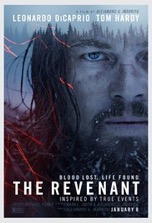The Revenant (R)
21/02/16 21:44 Filed in: 2016

Starring: Leonardo DiCaprio
January 2016
The below comments (in Black) were originally tweeted in Real-time from the back row of a movie theater and appear @BackRoweReviews. Though efforts were made to tease rather than ruin this movie’s memorable lines and moments, some spoilers may exist in the following evaluation (in Red). For concerns over objectionable content, please first refer to one of the many parental movie guide websites. All ratings are based on a four star system. Happy reading!

“Keep breathing.” Beats the alternative.
Never seen a river flow through trees like this.
Phantom arrows and friendly fire...they don’t stand a chance.
“Get off the boat.” #Unwise
“I ain’t got no life.” #PeltLife
Two bear cubs. Means momma is nearby. #GetOutOfThere
That #BearAttack is one ferocious sequence.
Leo might be wounded, but at least he has a #BearBlanket.
“Save your boy with a blink.” Intense scene.
Self-cauterizing a neck wound. #Ouch
God is a squirrel. Now I’ve heard it all.
Leo eats that fish #Gollum style.
Glass goes where the buffalo roam and the skies are cloudy all day.
“Your body is rotten.” Thanks for the compliment.
Silly Leo. Horses don’t fly.
Glass does the old #Tauntaun trick with his dead horse. It doesn’t smell good, but it’ll keep him warm.
“I need a horse and a gun.” Yeah! #RunningOnRevenge
Beautiful shot of the #Avalanche.
Final analysis: a cinematic masterpiece with a wholly immersive sense of place.
#AlejandroGInarritu has done for mountain forests what #DavidLean did for deserts in #LawrenceOfArabia.
Rating: 4 out of 4. A classic tale of revenge with superb acting by #DiCaprio and jaw dropping cinematography.
Ordinarily, a movie with liabilities like a dearth of dialogue, cursory character development and a standard cause-and-effect narrative wouldn’t be considered for Oscar’s top prize. But The Revenant isn’t an ordinary film. A good portion of the film’s success derives from its acting, particularly from Leonardo DiCaprio and Tom Hardy, who play diametrically opposed forces in a revenge yarn set during the frontier period. While Hardy is sufficiently loathsome as the movie’s treacherous antagonist, DiCaprio steals the show with a finely nuanced and physical demanding performance as Hugh Glass, a fur trapper with a half-breed son from his deceased Pawnee wife. Considering the high degree of difficulty inherent in this role and the fact that he’s long overdue for a win (5 previous nods), DiCaprio appears to be a shoo-in to snag the Best Actor Oscar, which would be justly deserved. Domhnall Gleeson and Will Poulter also turn in noteworthy supporting performances and the grizzly bear, played by Glenn Ennis in a blue suit, gets props (two paws up) for a solid assist. Another key ingredient in the movie’s winning formula is Alejandro G. Inarritu’s peerless direction; the film’s tone and visual style are directly attributable to Inarritu’s exceptional skills as a film craftsman. Inarritu has evoked incredibly visceral performances from his actors and has done so with minimal takes in arduous outdoor conditions. Having already won Best Director and Best Picture last year for Birdman, Inarritu seems poised to carry away another armful of statuettes at this year’s Oscars. Acting and directing aside, the production element that has elevated this film above the extant exemplars of woodland Westerns is the utterly mesmerizing lensing by cinematographer Emmanuel Lubezki. The movie’s dizzying array of POV shots, long takes and elaborate tracking shots have combined to form a type of visual poetry. The variety, complexity and audacity of these filming techniques, which effectively transport the viewer right into the middle of the action a la a FPS video game, is nearly unrivaled in cinema history (the only films that even come close are Peter Jackson’s Middle Earth trilogies, but those movies employed far more CGI). Whereas a director envisions a shot and the cinematographer frames it, the locations create the look and mood of a film. As such, the reason this film will go down as a masterwork of visual expression is its locations and the exquisite manner in which they were captured—the avalanche scene, filmed in a real-time one take, is a jaw-dropping achievement. Since the vast majority of this movie was shot on location (almost exclusively in the Canadian Rockies), the exteriors play a crucial role in creating the illusion of reality that moors the viewer to the milieu in palpable ways, wholly immersing them in this savage chapter in American history. The movie’s location scouts did a phenomenal job of discovering picturesque vantages and pinpointing the perfect setting for each camera setup, so kudos to them for their pioneering (sorry, couldn’t resist) work on this film. If you can get past its occasional brutal passage, this movie is a singular experience that far transcends the highest aspirations of the quotidian film in its genre. Which is to say, The Revenant is a cinematic marvel. Go see it or I’ll sick the bear on you.